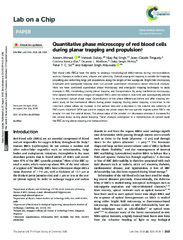Quantitative phase microscopy of red blood cells during planar trapping and propulsion
Permanent lenke
https://hdl.handle.net/10037/14675Åpne
Publisher's version (PDF)
Publisher's version (PDF)
Dato
2018-08-22Type
Journal articleTidsskriftartikkel
Peer reviewed
Forfatter
Ahmad, Azeem; Dubey, Vishesh; Singh, Vijay; Tinguely, Jean-Claude; Øie, Cristina Ionica; Wolfson, Deanna; Mehta, Dalip Singh; So, Peter T. C.; Ahluwalia, Balpreet SinghSammendrag
Red blood cells (RBCs) have the ability to undergo morphological deformations during microcirculation, such as changes in surface area, volume and sphericity. Optical waveguide trapping is suitable for trapping, propelling and deforming large cell populations along the length of the waveguide. Bright field microscopy employed with waveguide trapping does not provide quantitative information about structural changes. Here, we have combined quantitative phase microscopy and waveguide trapping techniques to study changes in RBC morphology during planar trapping and transportation. By using interference microscopy, time-lapsed interferometric images of trapped RBCs were recorded in real-time and subsequently utilized to reconstruct optical phase maps. Quantification of the phase differences before and after trapping enabled study of the mechanical effects during planar trapping. During planar trapping, a decrease in the maximum phase values, an increase in the surface area and a decrease in the volume and sphericity of RBCs were observed. QPM was used to analyze the phase values for two specific regions within RBCs: the annular rim and the central donut. The phase value of the annular rim decreases whereas it increases for the central donut during planar trapping. These changes correspond to a redistribution of cytosol inside the RBC during planar trapping and transportation.
Beskrivelse
Source at https://doi.org/10.1039/c8lc00356d.


 English
English norsk
norsk